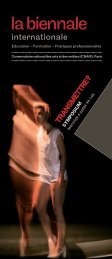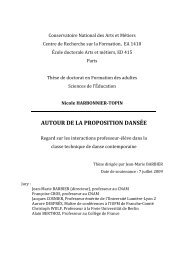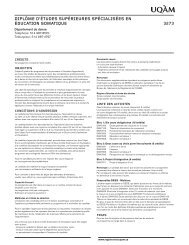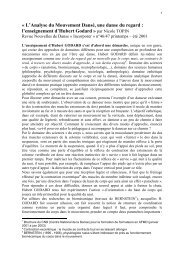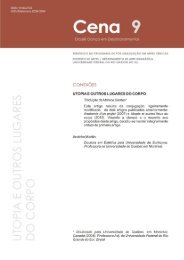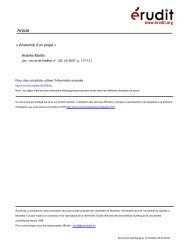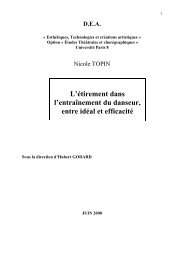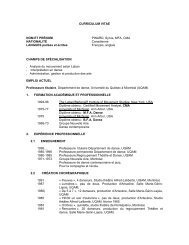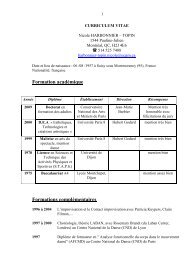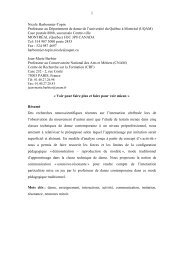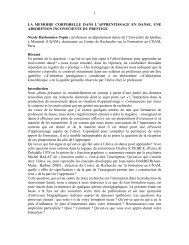Day 2 - Département de danse - UQAM
Day 2 - Département de danse - UQAM
Day 2 - Département de danse - UQAM
Create successful ePaper yourself
Turn your PDF publications into a flip-book with our unique Google optimized e-Paper software.
Full Conference Programme<br />
<strong>Day</strong> 1: Saturday, June 1<br />
9:00am-9:15am<br />
Opening Remarks: Allana C. Lindgren (University of Victoria) and Lynne van Luven (Acting<br />
Dean, Faculty of Fine Arts, University of Victoria), and Stephen Johnson (CATR/ACRT<br />
Presi<strong>de</strong>nt, University of Toronto)<br />
George<br />
9:15am-10:30am<br />
Keynote: Marie Clements, “A Creator's Gui<strong>de</strong> to The Unknown.”<br />
George<br />
Ma<strong>de</strong> possible by the CFHSS International Keynote Speaker Support Fund. Introduction: Sheila<br />
Rabillard (University of Victoria). Sponsors: Talonbooks and Canadian Theatre Review (Laura Levin,<br />
Editor-in-Chief)<br />
Marie Clements is an award-winning performer, playwright, director, screenwriter, producer, and co-director of Frog Girl Films<br />
and the newly formed Red Diva Projects. Her twelve plays, including Copper Thun<strong>de</strong>rbird, Burning Vision, and The Unnatural<br />
and Acci<strong>de</strong>ntal Women, have been presented on some of the most prestigious Canadian and international stages.<br />
10:30am — break (featuring an excerpt from Danette Boucher’s Lady Overlan<strong>de</strong>r in the Circular Plaza)<br />
10:45am-12:15pm<br />
a) The Performed Urban Body: I<strong>de</strong>ntities, Ethnographies, Economies George<br />
Open Panel Mo<strong>de</strong>rator: Kim Solga (Queen Mary, University of London)<br />
“Geographies of Performance: Cirque du Soleil and the Urban Context.” Susan Bennett<br />
(University of Calgary)<br />
Cirque du Soleil is one of Canada and Quebec’s best-known cultural producers with permanent and touring shows available to<br />
audiences in very many countries across several continents. In the first instance, then, this paper addresses the kinds of cities<br />
that host a Cirque du Soleil show and the cultural work it provi<strong>de</strong>s for them in the context of local planning and <strong>de</strong>velopment<br />
agendas. This is, in part, a question of physical geography, but, more specifically, it contributes to an economic geography of<br />
place. My paper will argue that the importance of Cirque du Soleil’s performance for the cities where their shows are seen is,<br />
to take a phrase from the conference CFP, to be at the economic edge. In other words, these performances often function to<br />
stimulate economic activity that extends far beyond the event itself.<br />
I will focus on the siting of touring shows both in Canada and elsewhere (with short, illustrated case studies), but engage,<br />
too, the successes and failures of permanent theatre locations in the United States and Asia, as well as the more recent move<br />
to arena versions of previously ‘big top’ shows so as to open up the Cirque du Soleil market as well as feed the ‘creative<br />
sector’ aspirations of smaller North American cities.<br />
Despite huge audiences for Cirque shows worldwi<strong>de</strong>, there is still very little published critical scholarship on the company,<br />
especially in English. This research is part of a larger project I have un<strong>de</strong>rway on the international circulation of performance<br />
culture. My most recent work inclu<strong>de</strong>s Theatre & Museums (Palgrave) and Shakespeare Beyond English (a co-edited<br />
collection from Cambridge, forthcoming in 2013).<br />
“Dis-ing the Main Drag in Here Be Dragons.” Andrew Houston (University of Waterloo)<br />
Two young men, who self-i<strong>de</strong>ntify as Asian-Canadian and queer, <strong>de</strong>ci<strong>de</strong> to leave the small, socially conservative southwestern<br />
Ontario city where they both grew up. They <strong>de</strong>ci<strong>de</strong> to perform the story of this <strong>de</strong>parture, its origins, its process, and its<br />
possible outcomes. The performance takes the form of a map, and before long each man maps a terrain vastly different from<br />
the other and different from what most who live in the city would recognize as home.<br />
José Estaban Muñoz argues that “i<strong>de</strong>ntities-in-difference” emerge out of a failed interpellation within the public sphere.<br />
Disi<strong>de</strong>ntifying with the dominant sphere allows for the emergence of a counter-public sphere; the landscape is the same, but<br />
the way it is mapped and used is different. Refuting both i<strong>de</strong>ntification and counter-i<strong>de</strong>ntification—or assimilation and antiassimilation—disi<strong>de</strong>ntification<br />
allows for a third mo<strong>de</strong> of <strong>de</strong>aling with dominant, embed<strong>de</strong>d i<strong>de</strong>ology that uses the i<strong>de</strong>a of<br />
“‘working [both] on and against’ as a strategy that tries to transform a cultural logic from within” (Muñoz 7).<br />
9



